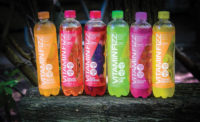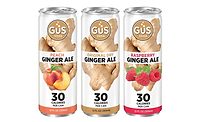In the ballad “The Sweetest Thing,” the pop rock band U2 sang about how love is the sweetest thing, but when it comes to the beverage market, the sweetest
| Jump to: |
thing also is the biggest thing. Across 13 ingredient categories, sweeteners accounted for 85 percent of the 46.4 million tons of ingredients used in beverages in 2011, according to an April 2013 report by Chicago-based Euromonitor International titled “Beverage Ingredients: Trends and Influences.”
With sweeteners playing such a large role in beverage formulation, the ingredient segment is at the forefront of some popular consumer trends.
Ihab Bishay, senior director of business development and application innovation for Fort Lee, N.J.-based Ajinomoto North America’s nutrition and health division, explains that consumer awareness about health and wellness, the obesity epidemic, and other health-related issues has resulted in consumers looking for healthier options in food and beverages.
“In the area of sweeteners, this has resulted in more beverage companies looking at ways to reduce the sugars, calories and carbohydrates in their products,” Bishay says. “This has led many in the beverage industry to look at formulating partial replacement of sugar in beverages sweetened with caloric sweeteners, such as sugar or [high-fructose corn syrup] (HFCS). These are products that are aimed at consumers looking for sugar-sweetened beverages but not necessarily all the calories associated with full sugar.”
He adds that it also is important that these reduced-calorie and sugar alternatives still maintain the same quality as their full-sugar counterparts at a level that is meaningful to consumers.
Sara Martens, vice president of the market research firm MSR Group, Omaha, Neb., notes that research from Chicago-based Mintel Research Consultancy has found that although consumers name sugar as the No. 1 ingredient they are trying to limit, their concern is more about how much sugar is being consumed versus the type of sugar. For example, when reading a nutrition label, 38 percent of consumers look at the calorie content while 28 percent look at the sugar content, she explains.
“I think they’re really interested in total sugar content and making a smarter choice when they can to limit or at least reduce the amount of sugar that they’re consuming,” she says.
According to “The Sweetener Story,” a white paper authored in consultation with Martens that features a May 2012 survey conducted by Mintel about consumer behavior and attitudes about sweeteners and HFCS, sugar or added sugar was the third-most looked for information on nutrition labels, trailing calories and fat and oils, respectively. This is the same position that sugar or added sugar maintained in a 2011 survey (calories and fats and oils switched positions), according to the study. However, the number of consumers that looked for HFCS was only 4 percent in 2012 (up 1 percent from the 2011 study), according to the research.
“The Sweetener Story” also tracked consumer awareness and found that awareness was up six points for stevia, two points for HFCS, three points for sugar, and five points for corn syrup in 2012, compared with 2011. Although awareness had increased on these specific sweeteners, Mintel referenced Google Trends to quantify opinions and actions to measure the impact of media on consumer behavior, according to the white paper.
“In spite of higher awareness and reported avoidance of HFCS, searches for HFCS have declined since 2009,” according to the report. “In the 52 weeks ending June 24, 2012, searches for ‘HFCS,’ which includes ‘corn syrup’ and ‘high-fructose corn syrup,’ declined 14 percent from 2009. In addition, searches for ‘sugar’ were 45 times higher than HFCS in the last year and rising. This illustrates the sheer magnitude of interest around sugar compared to HFCS.”
“For consumers, attitudes and actions show it’s not a matter of what type of sweetener is used but how much,” the report continues. “As for food and beverage manufacturers, they are discovering — when it comes to implementing a successful sweetener strategy — less is more.”
Blended family
As beverage-makers look for solutions to consumer concerns relating to sugar consumption and calorie reduction, many have opted to combine nutritive and non-nutritive sweeteners to meet this trend.
“What we’re seeing now is an increase in interest in blends of sweeteners to continue to produce great-tasting drinks with fewer calories,” says Stefanie Ringo, technical services senior supervisor for Cargill, Minneapolis. “For example, in the carbonated soft drink [category], the mid-calories ranging anywhere from 10 to 60 [calories] are a hot trend right now. They may use a high-intensity sweetener partnered with sucrose or high-fructose corn syrup or a more traditional nutritive sweetener.”
For manufacturers that are looking to offer a weight-management claim and need to utilize a non-nutritive solution but still are seeking a “natural” positioning, they can blend naturally sourced or plant-derived sweeteners with a nutritive ingredient as a solution, says Adams Berzins, principal technologist with Ingredion Inc., Westchester, Ill.
“Ingredion’s sweetness portfolio has a diverse offering including the naturally sourced, zero-calorie Enliten Reb[audioside]-A stevia sweetener and a natural, low-calorie bulking sweetener, Erysta erythritol,” he says. “For more traditional sweeteners, we have a nutritive portfolio including high-fructose and glucose syrups.”
Noting the popularity of brands like PepsiCo’s Tropicana Trop50, which is a blend of stevia and natural juice, James Kempland, vice president of marketing for Sweet Green Fields, sees more beverage manufacturers blending stevia with sugar to reduce calorie content without sacrificing taste.
“Beverage manufacturers are increasingly looking for options to respond to consumers’ demands for lower calories and ‘better-for-you’ products,” he says. “The trend, as Sweet Green Fields sees stevia unfolding, will be to create a ‘right-calorie’ segment in the beverage category — a product that blends the best of [both] worlds, sucrose/sugar and stevia, to provide consumers [with] all-natural, great-tasting, lower-calorie products.”
A proprietary composition of purified Rebaud-ioside-A, Sweet Green Field’s Optesse HPS is a high-purity yet flexible sweetener for blending with sugar and fructose, Kempland says. “[Optesse HPS is] ideal for all sugar-blended formulations from soft drinks to baked goods,” he adds. “The benefit is a clear, sweet taste with lower calories.”
Additional high-purity stevia extracts available from Sweet Green Fields include Optesse HPX, ideal for formulation with more complex flavor systems; Altesse Stevia 99, which is well-suited for zero-calorie formulations that require a clear, sweet taste; Sweetesse Stevia 97, which can be used in a range of product formulations including beverages; Greenesse Stevia 80, 60 and 50, which are well-suited to deliver a balance of taste and cost; and its upcoming organics line, Kempland says.
Noting that using pure stevia extracts can present a challenge because of a slight aftertaste, Thom King, president of Steviva Brands Inc., Portland, Ore., says the company offers Steviva Blend and Steviva Blend Fine Powder, which are both blends of stevia extract and erythritol. However, its most popular sweetener is Fructevia, a patented blend of non-genetically modified organism crystalline fructose, inulin, stevia extract and magnesium.
“We have found that Fructevia offers the beverage industry the best flavor profile and mouthfeel identical to HFCS or cane sugar,” he says.
Offering a portfolio of nutritive and natural high-intensity sweeteners, Cargill highlights its Truvia stevia leaf extract and Zerose erythritol, a high-digestive tolerance polyol or sugar alcohol, as natural and zero-calorie solutions for beverage formulations.
“New, natural, high-intensity sweeteners have been popular — you even see documentaries where people are combing the rainforests looking for the next new leaf that will give the next extract that will be the next natural sweetener,” Ringo says.
Also hitting on consumers’ health and wellness and natural trends is monk fruit, says Jeremy Thompson, director of product management and natural sweeteners for Tate & Lyle, London.
“Our research shows that monk fruit extract is highly compelling to consumers,” he says. “Many prefer monk fruit extract for sweetening their foods and beverages versus sugar. Monk fruit extract has strong purchase interest for a variety of foods and beverages. And consumers intuitively trust fruit — and monk fruit extract — for a clean, sweet taste due to the overall health halo associated with fruit.”
The company’s Purefruit brand, a monk fruit extract, has been sampled more than 1,000 times, and new products with the ingredient now are being launched in the marketplace, he adds. In addition to Purefruit, a number of sweetener solutions with synergistic capabilities are available from Tate & Lyle.
“Tasteva Stevia Sweetener and Purefruit are two natural, zero-calorie, high-potency sweeteners that Tate & Lyle offers,” says Megan Kirchhoff, food scientist with Tate & Lyle. “Beverage manufacturers have used them in multiple beverage categories such as juices, teas, [carbonated soft drinks], protein drinks, energy drinks, etc. Krystar crystalline fructose is a full-calorie sweetener from Tate & Lyle, which has great synergy with Purefruit monk fruit extract and has been most recently used in blends for beverage applications and frozen drinks. Fructose has the added benefit in that, in many applications, it is sweeter than sucrose, which permits a further reduction in calories in products if this is a goal.”
Sweet formulations
When selecting a sweetener system, many factors are considered during formulation; however, taste is the top consideration, experts note.
“The most important formulation recommendation is to focus on the taste of the beverage and to select a sweetener that has a clean, sweet taste with no off-notes,” Ajinomoto’s Bishay says. |
“The most important formulation recommendation is to focus on the taste of the beverage and to select a sweetener that has a clean, sweet taste with no off-notes,” Ajinomoto’s Bishay says. “In this way, your formulation work can focus on delivering great taste to your consumers instead of focusing on masking the off-tastes of your sweeteners.”
Bishay notes that aspartame offers a clean, sweet taste that can be used as the sole sweetener but also can be blended with other well-known sweeteners such as sugar, acesulfame potasssium — with which it has a strong synergy — and many others. The company also is developing two new sweeteners, he adds.
“Advantame is a sweetener and flavor enhancer — currently approved only as a flavor enhancer — that is 20,000 [times] sweeter than sugar,” Bishay says. “Advantame will be able to reduce a portion of the sugar and calories in beverages while maintaining the same great taste or enhancing the flavor of the beverage while reducing cost. The increased awareness of added sugar and calories together with the rising cost of sugar will ensure that the sugar-reduction trends will continue to gain momentum for some time to come.”
In order to tailor solutions and recommendations to specific beverage formulations, Ajinomoto recently opened its Customer Applications Center in Itasca, Ill.
“This allows [customers] to complete their projects faster and, of course, much more cost effectively than if they did it themselves,” Bishay says. “This works because we leverage our wide-ranging experience with all sweeteners and present solutions that meet or exceed our customers’ expectations, using all sweeteners and formulation technology available to the industry.”
And when it comes to formulation, ingredient suppliers are looking to help manufacturers find not only the best sweetener solution but also keep costs in check.
“Beverage manufacturers are developing cost-effective products that are also lower in calories,” says Mary Hunt, product manager for Tate & Lyle. “For example, the use of high-intensity sweetener Splenda sucralose can be both very cost effective in reducing calories and sugar yet delivering the same sweetness as a full-sugar product. Research also shows consumer acceptance of Splenda sucralose is high.”
Cargill’s Ringo notes that research and development continues to be done to support the supply chain and keep costs down. “Everyone from a food and beverage manufacturing supply standpoint is very cost conscious,” she says. “So, if your product is grown and processed in Brazil, for instance, and you have to import, how could you use technology to change that supply chain and make it available here?”







